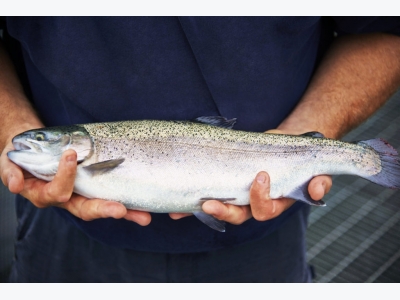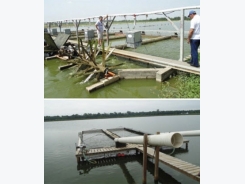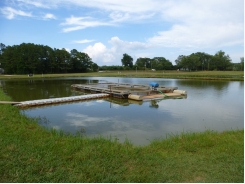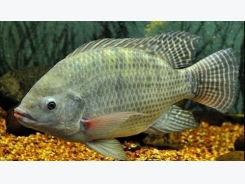For Great Lakes aquaculture, its a tale of two countries

In the waters they share, United States and Canada clash on fish farming
A farmed trout raised by Blue Goose Fish Farm in Manitoulin Island, Ontario.
Canada and the United States may be neighbors, but when it comes to aquaculture in the Great Lakes – Superior, Huron, Michigan, Ontario and Erie – the two countries are on opposite sides of the fence.
“Fish farming in Michigan is very small,” said Dan Vogler, owner of Harrietta Hills Trout Farm, a flow-through hatchery in Michigan that primarily grows and sells rainbow (Oncorhynchus mykiss), brook (Salvelinus fontinalis) and brown (Salmo trutta) trout. “Certainly nowhere near the scale of Ontario, and the general landscape of aquaculture in Michigan over the last 20 years has not changed. There has been no growth in the industry as a whole.”
It’s been an ongoing struggle to kick-start aquaculture in Michigan. In 2016, the Sierra Club and the Anglers of the Au Sable challenged Vogler’s permit to operate a fish hatchery in Grayling, and in February 2017, Flint Congressman Dan Kildee introduced a bill to virtually ban fish farming in the Great Lakes and federal “Wild and Scenic Rivers.” Currently, there are no net pens in Great Lakes waters in the United States, but a handful of licensed pens operate on the Canadian side in Lake Huron.
“There were proposals over the last couple of years to [look] at aquaculture opportunities with net pens in the Great Lakes,” said Vogler. “The response back was it was too high a risk and we didn’t have enough information. Completely ignoring 30 years of Canadian experience in Lake Huron.”
Risks to recreation
Recent talk of aquaculture expansion into the Great Lakes basin has largely been quashed in Michigan. In 2016, the state’s departments of Natural Resources, Environmental Quality and Agriculture and Rural Development released a report concluding that commercial fish farming in the Great Lakes would “pose significant risks to fishery management and other types of recreation and tourism,” and would be too expensive for the state to oversee.[2] As it stands, commercial net pens cannot legally operate in the Michigan portion of the Great Lakes, and out of nearly 1,700 written comments received by the departments, more than 1,600 were in opposition to expansion.[3]
“We don’t support net-pen aquaculture in the Great Lakes,” said Gail Philbin, director of the Sierra Club’s Michigan chapter. “We aren’t opposed to all aquaculture across the board, but we do have grave concerns about aquaculture facilities that are hydrologically connected to wild fisheries, especially through surface waters.”
Although it borders the same bodies of water, nearby Ontario could be considered an alternative universe, where Great Lakes aquaculture has thrived since the early 1980s. There are at least six licensed cage facilities in Lake Huron, primarily raising rainbow trout, along with First Nations’ aquaculture sites in Ontario that independently operate according to their own tribal licensing system.
The danger is that opportunities are happening over on [the Canadian] side, and we can’t find our way out of a paper bag over here.
“The fact that there is development during the past two decades suggests that both [federal and provincial] governments see some merit in developing aquaculture in the Great Lakes,” says Dr. Michael Rennie, Canada Research Chair in Freshwater Ecology and Fisheries and assistant professor in the Department of Biology at Lakehead University.
According to University of Guelph researchers, the total annual contribution that aquaculture makes to the Ontario economy is estimated to exceed $80 million, with additional economic value realized via the recreational and aquaria trade.[4] Anyone interested in establishing a cage aquaculture facility is required to apply to the Ontario Ministry of Natural Resources and Forestry (MNRF).
“Compared to Michigan, Ontario is quite reasonable,” said Gord Cole, owner of Aqua-Cage Fisheries Ltd in Parry Sound, Ontario. “It is possible, theoretically, to get a license in Ontario, which it’s not in Michigan.”

Blue Goose Fish Farm in Manitoulin Island, Ontario.
Precautionary principle, or politics?
A trailblazer in Ontario’s aquaculture industry, Cole has operated a net pen fish farm in Georgian Bay since 1982 – possibly the oldest continuously operated cage farm anywhere in North America.[5] As Cole speculates, the polar opposite treatment of aquaculture across the Michigan-Ontario borders boils down to “politics.”
“It’s not science-based,” said Cole. “The decisions [in Michigan] are made by a combination of politicians and fisheries people, who often see no benefit to [aquaculture].”
“[Michigan is] just nervous,” added Mike Meeker, founder of Meeker Aquaculture and manager of the Blue Goose Fish Farm in Manitoulin Island, Ontario. “Even [those] in support are nervous about moving ahead. They promote the precautionary principle, which is move ahead with caution and analyze what you’re doing. Michigan, unfortunately, is interpreting [this] as don’t do anything – and that’s wrong.”
The development of aquaculture is seen as competitive rather than complementary.
As Michigan fish farmers point out, it’s more than perceived or actual environmental risks that spook some from advancing aquaculture production: The political clout of anglers also may shape Michigan’s decision-making.
“In Michigan, we’ve primarily given priority to recreational uses,” said Joe Colyn, an agronomist, food professional and founder of Originz, a company that supports the creation of new food systems. “The development of aquaculture is seen as competitive rather than complementary. It doesn’t take a lot of space in our Great Lakes waters to grow a lot of fish, and we just have to do more education [to the public].”
“In Michigan, water is for looking at, for water-skiing, for sport fishing,” said Vogler. “It is not for farming. Sport fishing groups hold the greater political influence over how water gets used in Michigan.”
Dr. Rennie speculates that U.S. and Canadian governmental structures may also be a factor.
“I suspect the difference largely lies in the fact that aquaculture promotion is a mandated aspect of Fisheries and Oceans Canada (DFO), [a] federal body responsible for the sustainability of fisheries in this country,” he said. “No such mandate exists for any organization in the U.S. that I know of.”
Support for expansion
However, Cole and Meeker emphasize that Ontario is no utopia and politics play a role as well. Cottage owners in Georgian Bay lobbied against aquaculture in the 1990s, triggering policy changes that allegedly stalled growth in the sector. According to University of Guelph researchers, Ontario’s aquaculture production has been “relatively stagnant for the past 15 years,”[6] citing an “uncertain, and still confusing aquaculture licensing system” that hampers start-up of new farms, especially open water net pen sites in the Great Lakes.[7]
“The attitude changed, particularly with this push by [the Georgian Bay Association],” said Meeker. “It’s been very restrictive for the last 10 [to] 15 years. It’s disappointing, because we’ve proven that we’re not having any negative effect [from] 30 years’ worth of intensive data.”
Government gripes aside, aquaculture producers in Ontario are mostly hopeful about the industry’s future, especially with proposed policy changes geared to ease the regulatory burden and recent signs of industry growth. In 2015, Ontario’s farmed production of rainbow trout exceeded 4,500 metric tons, a 13 percent gain over the previous year.[8]
“Over the next five to 10 years, there’s going to be significant expansion in Ontario,” said Cole. “Incremental, but we’ll probably double production in Ontario, [mostly] as a result of improved production on existing farms. Not more cages or anything, just improved management.”

Feeding the trout at the Blue Goose Fish Farm in Manitoulin Island, Ontario.
Lack of alignment
In Michigan, producers remain optimistic that increased public education and sharing of research can help chart the course forward.
“I believe that we’ll get to the point in the region where we can create a thriving sustainable aquaculture,” said Colyn. “We’re still learning our way into it. We can learn from the mistakes from the last few decades and we can grow the sector pretty quickly.”
“We have to learn to use the resources that we have to raise fish,” said Vogler. “So that means surface water and flow-through systems, and eventually, we build up an entire sector that involve[s] feed mills, processing […] research and hatcheries.”
Still, some in Canada and the United States remain opposed to any aquaculture development on the Great Lakes.
“GBA has encouraged Ontario to align their aquaculture policies with the eight Great Lake States,” said Bob Duncanson, executive director of Georgian Bay Association, an umbrella group of 20 cottage associations, representing over 4,000 families along the eastern and northern shores of Georgian Bay. “The State of Michigan has regulations in place that prohibit open net aquaculture in their part of the Great Lakes. We think that it is inappropriate for Ontario to allow a polluting activity that our partnering jurisdictions on the Great Lakes do not allow.”
Something like aquaculture is a non-consumptive use of our water. If you regulate it properly, you can use the water and really not hurt it.
“When it comes to the Great Lakes, both the U.S. and Canada share these water resources,” said Congressman Dan Kildee (D-Mich.). “There is no physical barrier separating waters for either country. I do not support aquaculture in the Great Lakes, either in the U.S. or Canada, because it has not been proven to be safe. The pollution or byproducts of aquaculture can lead to fish kills and harmful algal blooms that would jeopardize our fresh water. The U.S. and Canada must work together to protect the Great Lakes from harm, including from the threat of improper aquaculture practices.”
Such comments put any cross-border collaboration efforts in doubt. The lack of consensus between governments could mean future aquaculture opportunities will be one-sided.
“The danger is that opportunities are happening over on [the Canadian] side, and we can’t find our way out of a paper bag over here,” said Vogler.
“They don’t coordinate on aquaculture because we’re not having a negative impact on fisheries,” said Cole. “There are some legitimate concerns about fish farming and some things that need to be regulated to prevent negative environmental and ecological impacts. Fish farming is one of those things as long as you do it properly, it’s beneficial; if you do it incorrectly, you can have negative impacts.”
“There is a long history of cooperation on water quality and fisheries issues on the Great Lakes under the IJC (International Joint Commission) and GLFC (Great Lakes Fisheries Commission),” said Dr. Rennie of Lakehead University. “In large part, it’s because there hasn’t been much of a push on the U.S. side to develop aquaculture on the Great Lakes, rather than a lack of desire to collaborate. The mechanisms and connections are there to facilitate such collaboration.”
Despite the differences, a common desire exists in the aquaculture industry for evidence-based decision-making on both sides of the border. As Vogler emphasizes, this means developing aquaculture in the Great Lakes in a “methodological, intentional, careful and responsible way.”
“In a fresh-water starved world, we are in a very unique position,” said Vogler. “Something like aquaculture is a non-consumptive use of our water. If you regulate it properly, you can use the water and really not hurt it.”
Author:
Lisa Jackson is a writer based in Toronto, Canada, who covers a range of food and environmental issues. Her work has been featured in Al Jazeera News, The Globe & Mail and The Toronto Star.
Related news
Tools

Phối trộn thức ăn chăn nuôi

Pha dung dịch thủy canh

Định mức cho tôm ăn

Phối trộn phân bón NPK

Xác định tỷ lệ tôm sống

Chuyển đổi đơn vị phân bón

Xác định công suất sục khí

Chuyển đổi đơn vị tôm

Tính diện tích nhà kính

Tính thể tích ao




 Tilapia Fish Farming Information Guide
Tilapia Fish Farming Information Guide  A warning and an improved PCR detection method…
A warning and an improved PCR detection method…